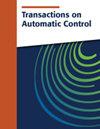A Hamilton–Jacobi–Bellman Approach to Ellipsoidal Approximations of Reachable Sets for Linear Time-Varying Systems
IF 7
1区 计算机科学
Q1 AUTOMATION & CONTROL SYSTEMS
引用次数: 0
Abstract
Reachable sets for a dynamical system describe collections of system states that can be reached in finite time, subject to system dynamics. They can be used to guarantee goal satisfaction in controller design or to verify that unsafe regions will be avoided. However, conventional grid-based methods for computing these sets suffer from the curse of dimensionality, which typically prohibits their use for systems with more than a small number of states, even if they are linear. In this article, we demonstrate that local viscosity supersolutions and subsolutions of a Hamilton–Jacobi–Bellman equation can be used to generate, respectively, under-approximating and over-approximating reachable sets for time-varying nonlinear systems. Based on this observation, we derive dynamics for a union and intersection of ellipsoidal sets that, respectively, under-approximate and over-approximate the reachable set for linear time-varying systems subject to an ellipsoidal input constraint and an ellipsoidal terminal (or initial) set. The dynamics for these ellipsoids can be selected to ensure that their boundaries coincide with the boundary of the exact reachable set along a collection of solutions of the system. The ellipsoids can be generated with polynomial computational complexity in the number of states, making our approximation scheme computationally tractable for continuous-time linear time-varying systems of relatively high dimension.线性时变系统可达集椭球逼近的Hamilton-Jacobi-Bellman方法
动态系统的可达集描述了在有限时间内可以达到的系统状态的集合,服从于系统动力学。它们可以用来保证控制器设计的目标满足或验证不安全区域将被避免。然而,用于计算这些集合的传统基于网格的方法受到维度的诅咒,这通常禁止它们用于具有少量状态的系统,即使它们是线性的。在本文中,我们证明了Hamilton-Jacobi-Bellman方程的局部粘度超解和子解可以分别用于生成时变非线性系统的欠逼近和过逼近可达集。基于这一观察,我们推导了椭球集的并集和交集的动力学,分别对椭球输入约束和椭球端(或初始)集的线性时变系统的可达集进行了欠逼近和过逼近。可以选择这些椭球的动力学,以确保它们的边界沿着系统的解集合与精确可达集的边界重合。椭球体在状态数上可以以多项式的计算复杂度生成,使得我们的逼近方案在计算上易于处理相对高维的连续时间线性时变系统。
本文章由计算机程序翻译,如有差异,请以英文原文为准。
求助全文
约1分钟内获得全文
求助全文
来源期刊

IEEE Transactions on Automatic Control
工程技术-工程:电子与电气
CiteScore
11.30
自引率
5.90%
发文量
824
审稿时长
9 months
期刊介绍:
In the IEEE Transactions on Automatic Control, the IEEE Control Systems Society publishes high-quality papers on the theory, design, and applications of control engineering. Two types of contributions are regularly considered:
1) Papers: Presentation of significant research, development, or application of control concepts.
2) Technical Notes and Correspondence: Brief technical notes, comments on published areas or established control topics, corrections to papers and notes published in the Transactions.
In addition, special papers (tutorials, surveys, and perspectives on the theory and applications of control systems topics) are solicited.
 求助内容:
求助内容: 应助结果提醒方式:
应助结果提醒方式:


